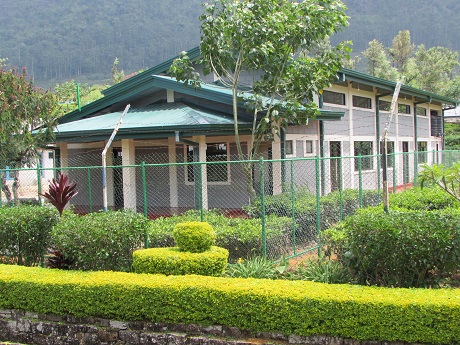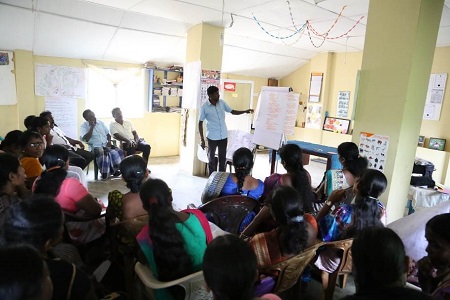New Community Centre for Medakumubura Estate Residents
Human Development Initiative through Empowerment and Settlement Improvement in the Plantation Settlements in Sri Lanka.
Common indoor spaces are vital for communities in rural Sri Lanka as places to meet, hold special events and to obtain extended government services. In many villages, especially in the central hilly regions, such common buildings are not readily available due to the lack of financial resources. UN-Habitat, through the project “Human Development Initiative through Empowerment and Settlement Improvement in the Plantation Settlements in Sri Lanka (HDI)” is providing a number of infrastructure facilities such as Child Development Centres, internal access roads, storm water drainage and Multi-Purpose Community Centres (MPCCs) to selected villages in Nuwara Eliya District.
Funded by the Korea International Cooperation Agency (KOICA), the HDI project aims to empower and build resilient plantation communities with satisfactory living conditions, safer settlements, better access to basic services and improved livelihood skills. One of the key objectives of the project is to improve community infrastructure facilities in remote villages based on priorities identified by the communities. The project is currently implementing 18 infrastructure initiatives. At Medakumubura (Meddecombra) estate – one of the locations selected by the project, community members, in concurrence with the estate management, have selected the construction of an MPCC as their priority intervention.
Medakumubura estate, established in 1880, has a total land extent of 890 Hectares, including 462 Hectares of tea. The estate is situated 21 Km from Nuwara Eliya town, in the Kothmale Divisional Secretariat. It employs 755 workers with a resident population of approximately 5,000 people. Since its inception, the estate has been producing high quality black tea of the western, high grown variety. The Plantation Human Development Trust (PHDT), Medakumubura estate management as well as development agencies have provided a number of infrastructure facilities and introduced welfare programmes for the estate residents. These include housing, water and sanitation, a pre-school and medical facilities. The estate management is also preparing a sustainability plan with a focus on soil and water management and social aspects of the plantation residents.
When UN-Habitat commenced project activities at Medakumbura estate, a Community Action Planning (CAP) workshop was held to consult community members and identify their key issues and priority infrastructure needs. The lack of a dedicated indoor community centre was identified as a major challenge during this discussion. The community members were facing difficulties due to the lack of a common space and were compelled to travel to distant locations to hold meetings and to get government services including services from the Grama Niladhari and basic public health
care services such as anti-natal and ‘well-baby’ clinics. In addition, as the village school did not have an auditorium. the school children had no space to conduct extracurricular activities such as concerts, dramas and cultural shows. Hence the construction of a MPCC would assist not only the adult residents but also the school children.
In keeping with UN-Habitat’s people’s participatory process of project implementation, the Meddecombra Estate Workers Housing Co-operative Society (EWHCS) was selected to implement the construction of the MPCC. This participatory methodology ensures that community members are involved in the planning and implementation of project activities, thus ensuring a sense of ownership and sustainability of the community assets while addressing the community’s real needs. The HDI project provided LKR. 11.2 Mn for the construction of the MPCC through UN-Habitat, while the community provided a financial contribution of LKR.25,000 as well as in-kind labour contributions. Once complete, the MPCC is expected to benefit over 4,500 people in the estate and adjoining villages.
UN-Habitat has provided vital technical support in the construction of the community centre. The assistance included the preparation of detailed plans and technical designs incorporating DRR measures, national construction standards, disability access and social, cultural and environmental sustainability features. UN-Habitat also prepared detailed BoQs and assisted the EWHCS to procure quality building materials. In addition, UN-Habitat has supervised the physical and financial progress and provided technical guidance on appropriate construction standards.
The MPCC has multiple features and will be utilised for many activities. The building is 3,240 square feet, consisting of a large hall that will be used for cultural events, meetings, weddings as well as important school activities such as concerts and prize giving ceremonies. A separate room is reserved for the public health midwife to provide health services to the community. The building also has an office room for the welfare officer, toilet facilities, and a dressing room. Once the construction work is complete, the garden will be landscaped and about 30 shade and fruit bearing trees will be planted to ensure a green environment.
The MPCC has been constructed with fair faced blocks for walls, Zinc Aluminium roofing sheets Aluminium window frames and wooden door frames. Disaster Risk Reduction features such as raised foundations, a braced structure with concrete columns, plinth beams, continuous lintel, roof beam and roof anchoring has been incorporated in the construction. The building design has incorporated the standards of post-disaster building guidelines of the Disaster Management Center, enabling its use as a temporary emergency shelter during a disaster situation. The building has been constructed with a ramp and guide rail providing easy access for disabled persons.
Mr. P.Vadival, the Samurdhi Development Officer, discussing the construction of the MPCC stated; ‘’I am very happy with the construction progress of the community centre. Once this building is complete, the estate residents will be greatly benefited and it will pave the way for a better future”.
Several direct as well as indirect employment opportunities have been created in the area through the construction activities. It is estimated that 1,440 skilled man–days as well as a number of unskilled man-days have been generated amongst the community through the construction of the MPCC. It is expected that the technical and management capacity of the Meddecombra Estate Workers Housing Cooperative Society will also improve significantly by implementing this project.
“This MPCC is being constructed based on community needs. It is a wonderful gift to our community.” K.Suthakaran, welfare officer of the Meddecombra Estate stated.
The HDI project is contributing towards human development through capacity building of youth, communities and local authorities; increasing resilience of the communities through settlement planning and community infrastructure; and through awareness creation towards mainstreaming plantation settlements. It is implemented in close collaboration with the Ministry of Hill Country New Villages, Infrastructure and Community Development. It is expected to benefit over 10,000 persons directly and 250,000 persons indirectly in Nuwara Eliya district. The project is being implemented from January to December 2017 in the Kothmale, Nuwara Eliya and Walapane Divisional Secretariat divisions.


